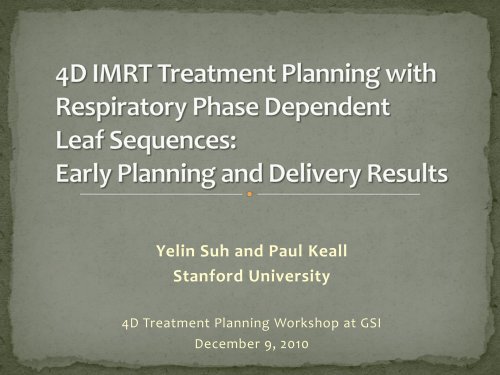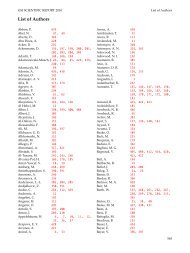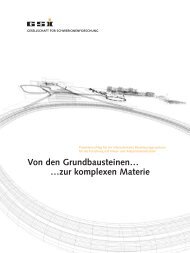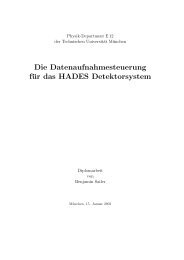Yelin Suh and Paul Keall Stanford University - GSI
Yelin Suh and Paul Keall Stanford University - GSI
Yelin Suh and Paul Keall Stanford University - GSI
You also want an ePaper? Increase the reach of your titles
YUMPU automatically turns print PDFs into web optimized ePapers that Google loves.
<strong>Yelin</strong> <strong>Suh</strong> <strong>and</strong> <strong>Paul</strong> <strong>Keall</strong><br />
<strong>Stanford</strong> <strong>University</strong><br />
4D Treatment Planning Workshop at <strong>GSI</strong><br />
December 9, 2010
Rationale for 4D Radiotherapy<br />
4D Treatment with Dynamic MLC Tracking<br />
4D Radiotherapy Treatment Planning<br />
Specific Solutions<br />
Towards General Solution<br />
Delivery of 4D Treatment Plans
Motion in radiotherapy<br />
“Respiration causes target motion, which is known to be one of the technical<br />
bottlenecks in radiotherapy, especially for stereotactic radiosurgery <strong>and</strong> IMRT.”<br />
Hypothesis<br />
<strong>Suh</strong> et al. “Aperture maneuver with compelled breath (AMC) for moving tumors:<br />
A feasibility study with a moving phantom,” Med Phys 31: 760-6, 2004<br />
Instead of seeing anatomic motion as an obstacle to radiotherapy,<br />
utilizing motion has potential to improve radiotherapy treatment.<br />
Including motion as an additional degree of freedom in radiotherapy<br />
treatment may yield at least as good solutions with motion tracking<br />
as those with no motion (motion = 0 is a subset of motion > 0).
Highly constrained treatment plan<br />
A 4D CT planning scan of<br />
one lung cancer patient with<br />
a small (3 cm 3 ), mobile tumor (2.1 cm)<br />
D 5% 36-40% ↓ D 5% 29-35% ↓
3D<br />
4D<br />
Planning Delivery<br />
3D CT<br />
Leaf Sequence for<br />
a 3D Treatment Plan<br />
L ( MU )<br />
4D CT<br />
Leaf Sequence for<br />
a 4D Treatment Plan<br />
L ( MU, θ )<br />
3D Plan<br />
Real-time 3D Target<br />
Position<br />
( x, y, z )<br />
Deliver in Treatment Machine<br />
Available technology Published (Sawant et al., 2008)<br />
Published (<strong>Suh</strong> et al.,<br />
2009; Gui et al., 2010)<br />
4D Plan<br />
Real-time 3D Target<br />
Position <strong>and</strong> Phase<br />
( x, y, z | θ )<br />
Deliver in Treatment Machine
4D IMRT treatment planning with dynamic MLC tracking<br />
including MLC leaf motion constraints, which takes<br />
respiratory motion into account <strong>and</strong> is robust to the<br />
variations of fractional time spent in respiratory phases<br />
within a given 4D CT planning scan<br />
4D Radiotherapy<br />
… is the explicit inclusion of the<br />
temporal changes in anatomy<br />
during the imaging, planning,<br />
<strong>and</strong> delivery of radiotherapy …<br />
ASTRO Meeting Panel Discussion, 2004<br />
Requires<br />
“Respiratory motion<br />
WILL change<br />
between imaging<br />
<strong>and</strong> delivery, <strong>and</strong><br />
between treatment<br />
fractions.”
4D IMRT treatment planning with dynamic MLC tracking<br />
including MLC leaf motion constraints, which takes<br />
respiratory motion into account <strong>and</strong> is robust to the<br />
variations of fractional time spent in respiratory phases<br />
within a given 4D CT planning scan<br />
4D Radiotherapy<br />
1. Imaging<br />
4D CT, as the best estimate<br />
2. Planning<br />
Treatment-planning optimization<br />
robust to variable motion<br />
3. Delivery<br />
Treatment-delivery system flexible<br />
enough to account for variable motion<br />
Requires<br />
“Respiratory motion<br />
WILL change<br />
between imaging<br />
<strong>and</strong> delivery, <strong>and</strong><br />
between treatment<br />
fractions.”
Ideal??<br />
Deliverable!!<br />
Extend 3D IMRT treatment planning to 4D<br />
with deliverable constraints
4D treatment planning that accounts for 3D target motion<br />
by applying real-time dynamic MLC motion-tracking algorithm<br />
<strong>Suh</strong> et al. “4D IMRT treatment planning using a dynamic MLC<br />
motion-tracking algorithm,” Phys Med Biol 54: 3821-35, 2009<br />
* Accounting for 1D motion along the major axis was<br />
previously published.<br />
<strong>Suh</strong> et al. “A deliverable 4D IMRT planning method<br />
for dynamic MLC tumor tracking delivery,”<br />
Int J Radiat Oncol Biol Phys 71: 1526-36, 2008<br />
Robust to the variations of fractional time spent in phases within 4D CT<br />
Not optimal, but deliverable with currently available technology<br />
Clear path to clinical implementation by using the same algorithm<br />
between planning <strong>and</strong> delivery for determining MLC leaf sequences
Integration of:<br />
General-purpose optimization system<br />
to optimize MLC leaf positions in L<br />
for individual respiratory phases<br />
Commercially available TP system<br />
to compute individual phase doses<br />
<strong>and</strong> a deformable-summed 4D dose,<br />
<strong>and</strong> Composite Objective Value,<br />
on the basis of L <strong>and</strong> H<br />
* SNOPT, Sparse Nonlinear OPTimizer (<strong>Stanford</strong> Systems Optimization Lab)
Solving various approaches within a common framework<br />
Solve general solution<br />
Framework for solving<br />
general solution<br />
Limiting<br />
degrees of freedom<br />
Solve more<br />
constrained solutions<br />
Assess clinical benefit of the general vs. more constrained solutions<br />
to 4D IMRT treatment planning with dynamic MLC tracking for<br />
radiotherapy treatment of thoracic <strong>and</strong> abdominal tumors
Inhale Phase<br />
Dashed: after 3D optimization<br />
Solid: after 4D optimization<br />
4D Plan<br />
Exhale Phase
Inhale Phase<br />
Dashed: after 3D optimization<br />
Solid: after 4D optimization<br />
4D Plan<br />
Exhale Phase
Apply the solutions to 4D CT scans of a cohort of lung cancer patients<br />
Perform treatment planning using the solutions for various<br />
4D treatment scenarios developed, on 4D CT planning scans<br />
of lung cancer patients to estimate the impact of 4D<br />
treatment planning for the population of lung patients<br />
Quantify the clinical benefit of 4D treatment planning<br />
Compare <strong>and</strong> evaluate treatment plans generated using<br />
various methods, in terms of clinical significance <strong>and</strong><br />
statistical significance on tumor dose escalation <strong>and</strong> healthy<br />
tissue dose reduction, <strong>and</strong> impact of the proposed work on<br />
the improvement of IMRT treatment of lung cancer
To experimentally investigate 4D treatment delivery<br />
to account for motion, rotation, <strong>and</strong> deformation of<br />
tumors <strong>and</strong> normal tissues<br />
Hypothesis<br />
Delivering 4D plans to account for the discrepancy<br />
between motion quantified from a 4D CT planning scan<br />
<strong>and</strong> that observed during each treatment delivery<br />
further improves the accuracy of radiotherapy treatment,<br />
as anatomy changes between imaging <strong>and</strong> delivery <strong>and</strong><br />
between treatment delivery fractions.
For lung or liver cancer patients with implanted markers:<br />
Imaging 4D CT planning scan<br />
Planning where motion, rotation, <strong>and</strong> deformation of<br />
tumors <strong>and</strong> normal tissues are included<br />
Delivery where target motion different from that in the 4D plan<br />
is accounted for, using real-time target localization<br />
Requirements:<br />
(1) treatment‐delivery system flexible enough to account for<br />
variable target motion during treatment delivery<br />
(2) real‐time information on both 3D position <strong>and</strong> phase of<br />
target motion from either measurement or estimation
4D<br />
Planning Delivery<br />
4D CT<br />
Leaf Sequence for<br />
a 4D Treatment Plan<br />
L ( MU, θ )<br />
4D Plan<br />
Real-time 3D Target<br />
Position <strong>and</strong> Phase<br />
( x, y, z | θ )<br />
Deliver in Treatment Machine<br />
3D target position <strong>and</strong> respiratory phase information<br />
quantified from<br />
a 4D CT planning scan<br />
Discrepancy<br />
incoming from<br />
a position monitoring<br />
system in real time
4D delivery when<br />
target motion during delivery is<br />
1) same as (3 cm)<br />
2) smaller than (1.5 cm)<br />
3) larger than (4 cm)<br />
motion during imaging (3 cm)<br />
Static delivery of<br />
each of individual phase plans<br />
for comparison
Static delivery<br />
Same motion during delivery as imaging<br />
Smaller motion during delivery than imaging<br />
Larger motion during delivery than imaging
Difference of ellipses<br />
between 4D <strong>and</strong> static delivery<br />
Translation/Motion Hysteresis<br />
Center X position 2.3 mm (0.1-5.1)<br />
Center Y position 2.1 mm (1.5-10.1)<br />
Rotation<br />
Orientation 1.3 o (0.2-4.0)<br />
Deformation<br />
Major axis length 0.6 mm (0-1.6)<br />
Minor axis length 0.7 mm (0.3-1.7)
Using motion as a degree of freedom for dynamic MLC tracking can<br />
improve radiotherapy treatment for 4D anatomy.<br />
Specific <strong>and</strong> general solutions to the 4D treatment planning with<br />
dynamic MLC tracking problem have been investigated.<br />
4D treatment plans for dynamic MLC tracking result in leaf sequences<br />
as a function of monitor units <strong>and</strong> respiratory phases.<br />
4D optimization with dynamic MLC tracking can generate a better 4D<br />
treatment plan than the sum of individually optimized phase plans.<br />
4D treatment plans can be delivered with current delivery technology,<br />
while accounting for variable target motion during delivery.
Acknowledgements<br />
- NIH/NCI grants R01 CA 93626 <strong>and</strong> P01 CA 116602<br />
- Philips Medical Systems<br />
- Varian Medical Systems

















